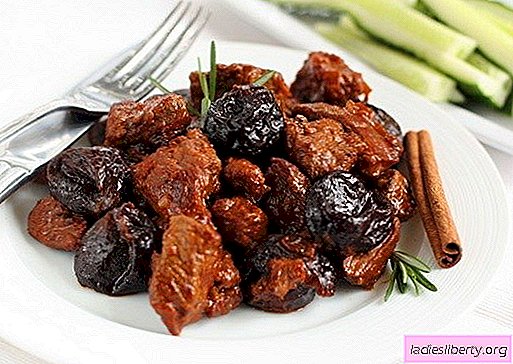
Dietary beef is one of the most popular foods for Russians. It has a wonderful taste, low calorie content and great benefits.
Composition and calorie content of beef meat
This meat in our country surpasses pork in popularity, it is more lean and has high nutritional properties. From beef you can cook a variety of first and second courses, salads and pastries. It is with beef that children begin to learn to "adult" food, as this meat rarely causes allergies and perfectly saturates.
The benefit of beef is explained by a set of substances that make up its composition:
• vitamins E, PP, B, E;
• minerals iron, calcium, magnesium, zinc, potassium, phosphorus, fluorine, copper, manganese, molybdenum;
• Essential amino acids arginine, isoleucine, valine, lysine, etc.
But the main value of beef as a food product is that 100 grams of beef pulp contains almost 20 grams of pure protein. At the same time, there is practically no fat in the fibers, which means that there is no load on the liver and cardiovascular system. The optimal combination of taste, nutritional value and beneficial properties - this is what beef nutritionists recommend for beef to promote health and weight control.
The benefits of beef
In Russia, the beneficial properties of red meat have long been known. A piece of beef could feed a large family. With meat, you can easily survive the long winter, return the weakened person the strength of the body and spirit.
Modern scientists have only confirmed what our ancestors knew about the benefits of beef:
• strengthens the heart muscle and blood vessel walls;
• prevents iron deficiency anemia by increasing hemoglobin;
• normalizes blood circulation;
• normalizes cholesterol, preventing the development of atherosclerosis due to the evacuation of "bad cholesterol";
• improves digestion, maintaining optimal acidity of gastric juice;
• normalizes metabolic processes;
• strengthens bones;
• forms muscle mass;
• makes nerves strong;
• improves memory.
Beef meat is especially needed by those who engage in heavy physical labor. However, with the fact that it works mentally, red beef meat is also very useful. A human body weakened after an illness can be restored as soon as possible by including boiled beef meat in the nutrition plan. Eating it in boiled or mashed form is possible and even necessary in the postoperative period, especially if the operation was accompanied by large blood loss.
If a person suffers from diseases of the cardiovascular system or intestines, then he can eat beef. There will be no harm from her, but one needs to know the measure. Moreover, one of the properties of beef broth is to increase blood coagulability, heal injuries and wounds, and restore muscles and ligaments. So it will be useful not only to sick people, but also to athletes.
Another feature of beef is that it has a beneficial effect on the digestive system: neutralizes salts and irritating enzymes, which means it reduces acidity in the digestive tract. This is a very valuable quality in diseases associated with improper functioning of the intestines and stomach.
Despite the fact that beef is an animal protein, it is absorbed by the body of a healthy person easily and quickly. This means that you should not be afraid of rotting and fermentation in the stomach, toxic poisoning and a dangerous load on the liver.
Moreover, scientists argue that a piece of beef is digested better than fruits, cereals and vegetables. Especially if the plate contains young beef or veal. Their fibers are tender, soft, and the taste is pleasantly milky.
That is why pediatricians recommend mashed boiled beef for the first meat foods or veal. Kids are happy to eat tasty meat with vegetables or cereals and grow strong and healthy.
Beef Harm
It is important to understand that all the beneficial properties of beef meat come to naught if you overeat. No matter how good assimilation beef is famous for, harm from exceeding the recommended dose of protein poses a serious threat primarily to the gastrointestinal tract, liver and kidneys.
People who do not know the measure in the use of red meat run the risk of ending their lives with patients of cardiology or another clinical department. Overeating will result in a critical increase in cholesterol, a decrease in immunity, the development of cardiovascular diseases, the formation of kidney stones, chronic inflammation of the liver and pancreas. In addition, there is a high risk of developing cancer.
The norm of beef meat in a plate of a healthy person is not more than 150 grams. This is an average. That is, physically working men, for example, can eat 20 grams more. Nevertheless, the norm of beef pulp should not exceed half a kilo per week.
Otherwise, putrefactive bacteria and toxins will accumulate in the colon, since the intestine will not be able to digest such an amount of meat. The result of bacterial activity will be the synthesis of substances such as phenol, skatol, putrescin, cresol, etc. All these are products of rotting protein foods. They can not only poison the intestines, but also spread throughout the body and affect the internal organs.
In addition, in the composition of beef, scientists identified the so-called purine bases. These are organic substances that contribute to the accumulation of uric acid harmful to the body. The harm is that uric acid provokes the development of urolithiasis, gout and osteochondrosis.
However, it’s possible to harm health if there is meat from an improperly grown animal. Antibiotics and hormones used to prevent diseases and increase the weight of animals are stored in meat and get on our table. Therefore, buying meat products from dubious sellers is very dangerous, especially if the meat is intended for the nutrition of children.
Beef and Slimming
Beef is indispensable for diets associated with losing weight. The fact is that calorie content of 100 grams of pulp ranges from 200 to 250 kcal. Moreover, the meat of animals specially grown on the farm and receiving nutritious feed will be more high-calorie.
Nevertheless, in any case, a piece of raw beef is almost not inferior to chicken meat from some parts of the carcass. That is why there is nothing better than using it as the protein basis of a meal for lunch or dinner. Supplementing beef with vegetables, you will get healthy, balanced BJU food. It will saturate for a long time, restore disturbed metabolic processes and help to lose weight.
However, the benefits of beef largely depend on how the meat is cooked. The most dangerous option for health is frying in oil. Not only is it really very harmful, it also increases the calorie content by almost a factor of two. In a 100-gram piece of steak fried in a pan - 380 calories. Compare: the same weight piece of boiled beef contains no more than 180 calories, stew - 230 calories.
Dietary beef is an important component of a healthy diet. If it cooks correctly and does not exceed the norm of protein food, you can strengthen your health and return the weight to normal.











